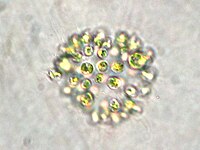
Strategies and ecological roles of algicidal bacteria
Sign Up to like & getrecommendations! Published in 2017 at "FEMS Microbiology Reviews"
DOI: 10.1093/femsre/fux029
Abstract: In both freshwater and marine ecosystems, phytoplankton are the most dominant primary producers, contributing substantially to aquatic food webs. Algicidal bacteria that can associate to microalgae from the phytoplankton have the capability to control the… read more here.
Keywords: roles algicidal; ecological roles; algicidal bacteria; physiology ... See more keywords

Algicidal Bacteria: A Review of Current Knowledge and Applications to Control Harmful Algal Blooms
Sign Up to like & getrecommendations! Published in 2022 at "Frontiers in Microbiology"
DOI: 10.3389/fmicb.2022.871177
Abstract: Interactions between bacteria and phytoplankton in aqueous ecosystems are both complex and dynamic, with associations that range from mutualism to parasitism. This review focuses on algicidal interactions, in which bacteria are capable of controlling algal… read more here.
Keywords: review current; control harmful; harmful algal; algicidal bacteria ... See more keywords

Isolation and characterization of algicidal bacteria from freshwater aquatic environments in China
Sign Up to like & getrecommendations! Published in 2023 at "Frontiers in Microbiology"
DOI: 10.3389/fmicb.2023.1156291
Abstract: Algicidal bacteria can inhibit the growth of algae or lyse algal cells, thus playing roles in shaping aquatic microbial communities and maintaining the functions of aquatic ecosystems. Nevertheless, our understanding of their diversities and distributions… read more here.
Keywords: isolation characterization; aquatic environments; characterization algicidal; bacteria freshwater ... See more keywords

Discovery of a High-Efficient Algicidal Bacterium against Microcystis aeruginosa Based on Examinations toward Culture Strains and Natural Bloom Samples
Sign Up to like & getrecommendations! Published in 2023 at "Toxins"
DOI: 10.3390/toxins15030220
Abstract: Harmful cyanobacterial blooms occur worldwide and pose a great threat to aquatic ecosystems and public health. The application of algicidal bacteria represents an eco-friendly strategy for controlling harmful cyanobacterial blooms; thus, searching for a high… read more here.
Keywords: microcystis; harmful cyanobacterial; microcystis aeruginosa; bloom ... See more keywords